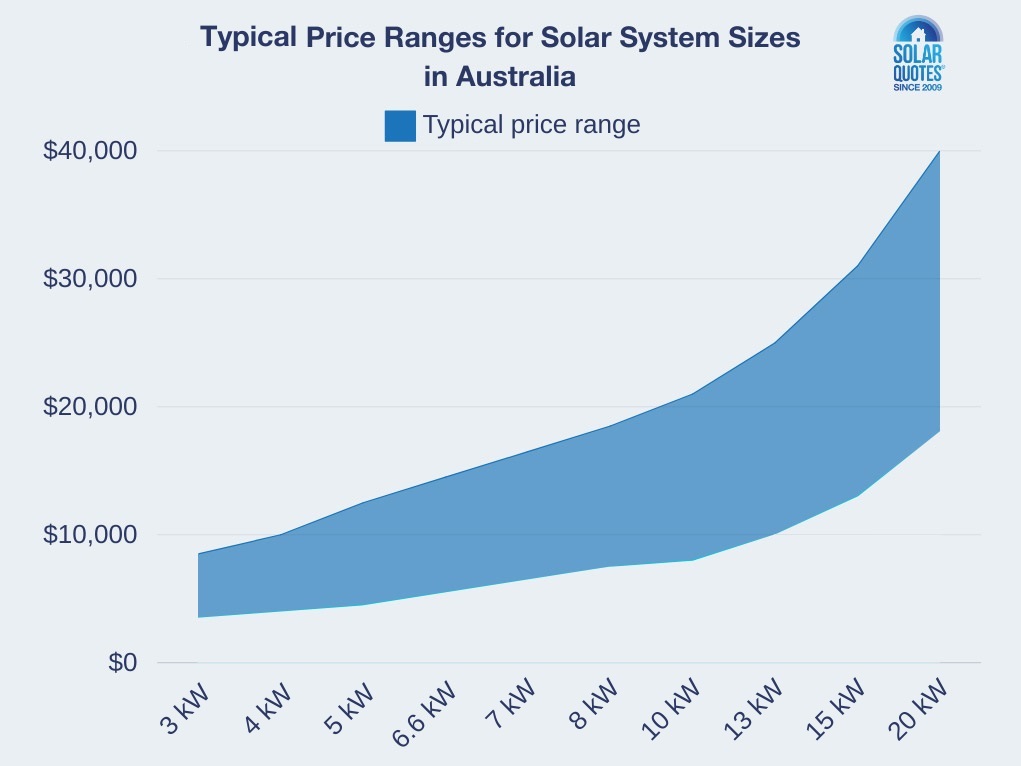How Much Do Solar Panels Cost?
Last Updated: 27th Feb 2025 By Finn Peacock, Chartered Electrical Engineer, Fact Checked By Ronald Brakels

Prices in Australia have dropped significantly since I started SolarQuotes over a decade ago (when a piddly installation with 1 kW of solar panels cost $10,000!) – particularly pricing for larger systems. You’ll get far more capacity for the same money.
And despite what you may have heard, the price you’ll pay in 2025 for a PV system is still heavily subsidised by the Australian government-run solar rebate scheme.
The rebate fluctuates based on the value of things called STCs, which are explained in more detail on the page I linked to above. With the current price of STCs you are looking at up-front savings of about $350 per kW installed.
Here’s an example of how the pricing works out for a typical 6.6kW system, including installation:
(Note: these solar panel prices are very approximate and assume quality components are used in the installation. To get accurate pricing for your particular situation, I would advise getting 3 quotes from local installers I’ve pre-vetted.)
| Typical pre-rebate cost of an installed 6.6kW solar system: | $9,000 |
| Government Rebate: | $2,300 |
| Cost to you for 6.6kW of solar power: | Approx $6,700 |
Whether a 6.6kW system is an appropriate size installation for you or not is a good question. In 2025, it’s the minimum I’d recommend you put on your roof, and you should install more if you can. My longer reasoning is here.
Approximate Costs Of Solar Systems After the Rebate
The range of prices in Australia below is mainly down to the quality of the hardware used in the installation. To use a car analogy (as most people are more familiar with car brands than solar power brands), expect the lower price range to be “Kia” level brand and the upper cost to be a “BMW” level brand. I’ll leave you to decide if BMWs are worth paying more for than Kias!
For the absolute top-shelf components installed by a particularly fussy installer, you can expect a system to cost even more.
Here are approximate costs of a good quality solar system, fully installed, in Australia:
| System size | Number of panels | Cost Range (Jan 2025) |
| 3kW | 7 | $3,500 – $5,000 |
| 4kW | 9 | $4,000 – $6,000 |
| 5kW | 11 | $4,500 – $8,000 |
| 6.6kW | 15 | $5,500 – $9,000 |
| 7kW | 16 | $6,500 – $10,000 |
| 8kW | 18 | $7,500 – $11,000 |
| 10kW | 23 | $8,000 – $13,000 |
| 13kW | 30 | $10,000 – $15,000 |
| 15kW | 34 | $13,000 – $18,000 |
| 20kW | 45 | $18,000 – $22,000 |
Current panel prices fluctuate regularly – so don’t be surprised if your quotes are only valid for short time.
Note that the above assumes the use of 440W solar panels, so the final solar panel capacity may be a bit more or less than the figures mentioned.
See Real-Time Australian Solar Pricing
The costs quoted above are based on thousands of data points. To see real-time, average prices being paid for full system installations of various capacities in your state, check out the SolarQuotes Solar Price Index.
Microinverter/Optimiser Cost
If you want a good quality microinverter or optimiser system installed, expect to add around 20% in cost to the above price ranges.
Finding The Money
You may be looking at those prices and thinking: “Wow, that’s a lot of money to find!” even with the rebate. I agree. This is why it is important for Australians to understand the payback and cashflows involved with solar panels, so you can assess if the cost of an installation is going to be a worthwhile investment for you.
To help with this, I’ve created a “no BS” solar payback calculator that lets you try out different options and see the overall solar energy savings and cash flows over the lifetime of your system.
I should also point out that you can buy solar systems at prices much lower than those detailed above. But I would be wary of the quality of the components (not just the solar panels) and installation that you will get if the price seems too good to be true.
Whether you finance your system installation via savings or by adding it to your mortgage, at current interest rates, your solar power system effectively pays for itself from the start. By that I mean the savings from your reduced bills may outweigh either the extra repayments or the lost interest on your savings. Again this depends on lots of variables – so do your research.
If you’re considering installing solar panels for your home or business, SolarQuotes can help you get quotes from high-quality Australian installers quickly and easily:
>>Next: What Different Types Of Solar Panel Are Out There For You To Choose From? >>